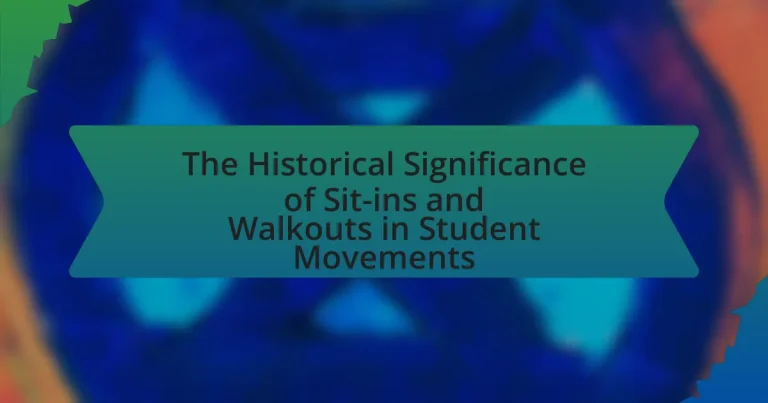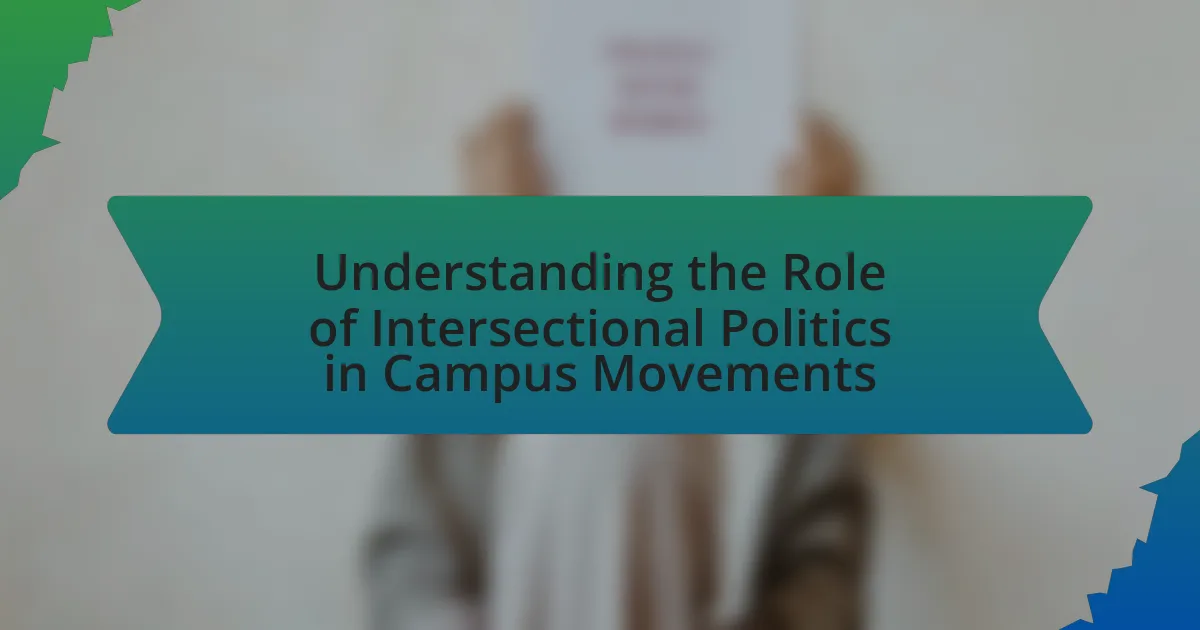The article examines the historical significance of sit-ins and walkouts as forms of nonviolent protest within student movements. It outlines how these tactics emerged during the Civil Rights Movement, highlighting key events such as the Greensboro sit-ins and the East Los Angeles walkouts, which challenged racial segregation and educational inequalities. The discussion includes the impact of these actions on public perception, policy changes in educational institutions, and their evolution in modern activism, addressing contemporary issues like gun violence and climate change. The article emphasizes the lessons current student activists can learn from historical examples to enhance their effectiveness in advocating for social justice.
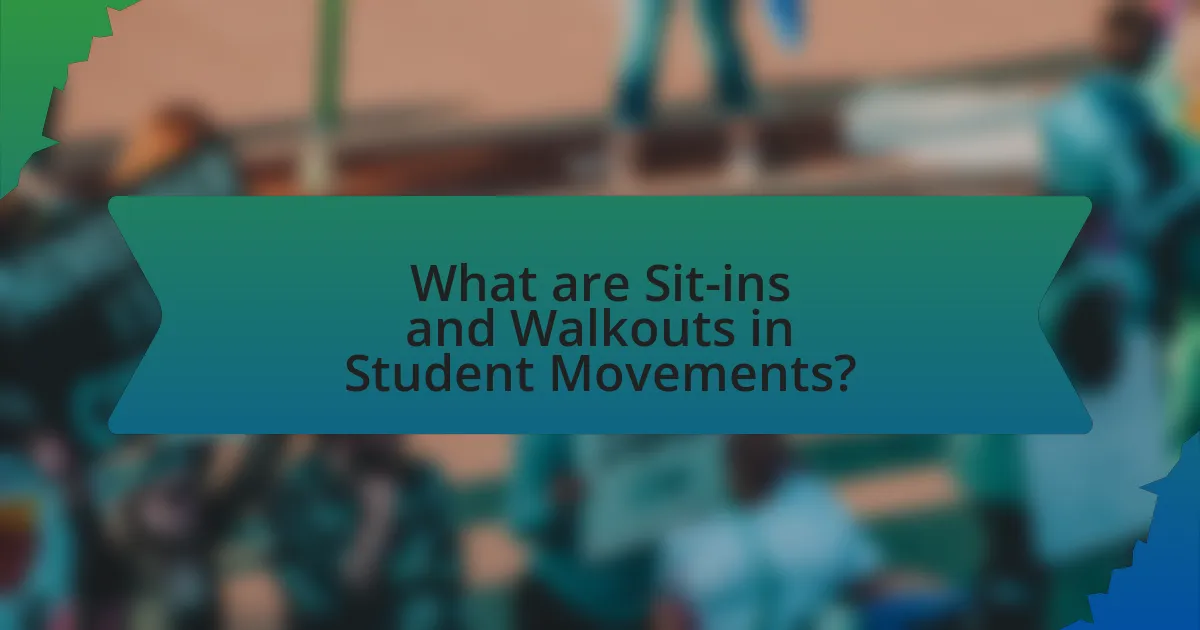
What are Sit-ins and Walkouts in Student Movements?
Sit-ins and walkouts are forms of nonviolent protest used by students to express dissent and demand change within educational institutions or society at large. Sit-ins involve students occupying a space, such as a cafeteria or administrative office, to disrupt normal operations and draw attention to their grievances, often advocating for civil rights or social justice, as seen during the Civil Rights Movement in the 1960s. Walkouts, on the other hand, entail students leaving classes or school premises to protest against policies or actions they oppose, such as gun violence or inadequate educational resources, exemplified by the March for Our Lives movement in 2018. Both tactics serve as powerful tools for mobilizing student activism and raising awareness about critical issues, demonstrating the historical significance of student movements in effecting social change.
How did Sit-ins and Walkouts emerge as forms of protest?
Sit-ins and walkouts emerged as forms of protest primarily during the Civil Rights Movement in the United States, particularly in the late 1950s and early 1960s. These methods were adopted by students and activists to challenge racial segregation and injustice, with sit-ins often taking place at segregated lunch counters, where participants would peacefully occupy the space to demand service and equality. The Greensboro sit-ins of 1960, initiated by four African American college students, exemplified this approach and sparked similar protests nationwide, demonstrating the effectiveness of nonviolent resistance. Walkouts, on the other hand, were used by students to protest against educational inequalities and oppressive policies, such as the East Los Angeles walkouts in 1968, which highlighted the need for better educational opportunities for Chicano students. Both forms of protest became significant tactics in mobilizing youth and raising awareness about social issues, ultimately contributing to broader movements for change.
What historical events led to the rise of Sit-ins and Walkouts?
The rise of sit-ins and walkouts was significantly influenced by the Civil Rights Movement in the United States during the 1950s and 1960s. Key events, such as the Greensboro sit-ins in 1960, where four African American college students protested segregated lunch counters, demonstrated the effectiveness of nonviolent resistance and inspired similar actions across the country. Additionally, the anti-Vietnam War protests in the late 1960s, particularly among college students, led to widespread walkouts as a form of dissent against government policies. These events collectively galvanized student activism, establishing sit-ins and walkouts as powerful tools for social change and political expression.
How did these actions reflect the social and political climate of their time?
The actions of sit-ins and walkouts during student movements reflected a growing discontent with systemic racism and social injustice prevalent in the 1960s. These protests emerged as a direct response to the civil rights movement, highlighting students’ demands for equality and an end to segregation, particularly in educational institutions. For instance, the Greensboro sit-ins in 1960 demonstrated students’ refusal to accept discriminatory practices at lunch counters, symbolizing a broader challenge to societal norms. The widespread participation in these actions indicated a shift in the political climate, where young people began to assert their voices against established authority, ultimately influencing legislation such as the Civil Rights Act of 1964.
Why are Sit-ins and Walkouts significant in the context of student activism?
Sit-ins and walkouts are significant in the context of student activism because they serve as powerful forms of nonviolent protest that effectively draw attention to social injustices and demand change. Historically, these actions have mobilized large groups of students, exemplified by the Greensboro sit-ins in 1960, which challenged racial segregation in the United States and inspired similar protests nationwide. Such events not only highlight the collective voice of students but also demonstrate their ability to influence public policy and societal norms, as seen in the aftermath of the Kent State University protests in 1970, which led to increased scrutiny of U.S. military involvement in Vietnam. These tactics have proven to be effective tools for raising awareness and fostering dialogue around critical issues, thereby solidifying their importance in the landscape of student activism.
What impact did these actions have on public perception of student movements?
The actions of sit-ins and walkouts significantly shifted public perception of student movements, portraying them as powerful agents of social change. These protests highlighted students’ commitment to civil rights and social justice, garnering widespread media attention that amplified their messages. For instance, the Greensboro sit-ins in 1960 not only challenged segregation but also inspired similar actions nationwide, demonstrating the effectiveness of nonviolent resistance. This visibility helped to legitimize student activism in the eyes of the public, leading to increased support for their causes and influencing broader societal attitudes towards issues like racial equality and educational reform.
How did Sit-ins and Walkouts influence policy changes in educational institutions?
Sit-ins and walkouts significantly influenced policy changes in educational institutions by directly challenging discriminatory practices and demanding reforms. These actions, particularly during the Civil Rights Movement, highlighted the urgency for change, leading to the desegregation of schools and the implementation of more inclusive policies. For instance, the 1960 Greensboro sit-ins prompted many universities to reconsider their segregation policies, resulting in the integration of dining facilities and other services. Additionally, the 1970 Kent State University protests against the Vietnam War led to increased awareness of student rights and the establishment of more responsive governance structures within universities. These events collectively pressured educational institutions to adopt policies that promoted equality and addressed student grievances, demonstrating the power of collective action in effecting systemic change.
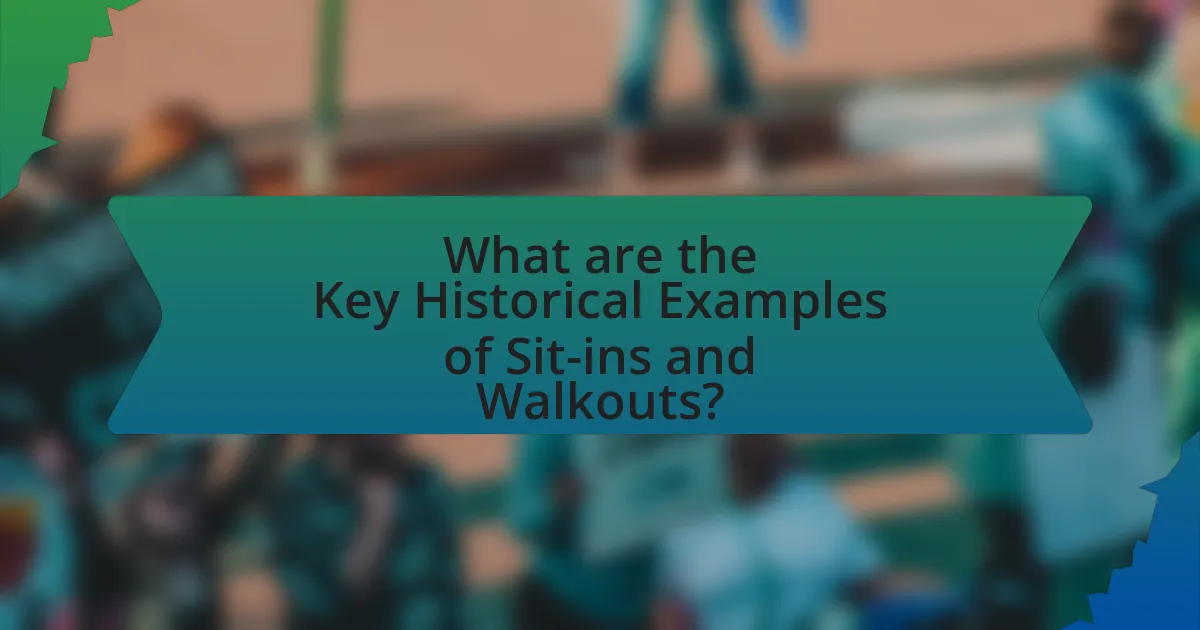
What are the Key Historical Examples of Sit-ins and Walkouts?
Key historical examples of sit-ins and walkouts include the Greensboro sit-ins of 1960, where four African American college students protested racial segregation at a Woolworth’s lunch counter in North Carolina, leading to widespread sit-in movements across the United States. Another significant example is the 1968 student walkouts in Los Angeles, where thousands of Chicano students protested against educational inequality and discrimination, resulting in increased awareness and policy changes in the education system. Additionally, the 1970 Kent State University protest, which included a walkout against the Vietnam War, became a pivotal moment in the anti-war movement after the tragic shooting of four students by the National Guard. These events collectively highlight the impact of sit-ins and walkouts in advocating for civil rights and social justice.
What notable Sit-ins occurred during the Civil Rights Movement?
Notable sit-ins during the Civil Rights Movement include the Greensboro sit-ins of 1960, where four African American college students initiated a nonviolent protest against segregated lunch counters in North Carolina. This event sparked similar protests across the country, leading to the desegregation of many public spaces. Another significant sit-in occurred in Nashville, Tennessee, where activists organized a series of sit-ins in 1960, resulting in the desegregation of lunch counters in the city. These sit-ins were pivotal in raising awareness and mobilizing support for the Civil Rights Movement, demonstrating the effectiveness of nonviolent protest in challenging racial segregation.
How did the Greensboro Sit-in shape the Civil Rights Movement?
The Greensboro Sit-in significantly shaped the Civil Rights Movement by demonstrating the effectiveness of nonviolent protest and mobilizing youth activism. Initiated on February 1, 1960, by four African American college students at a segregated Woolworth’s lunch counter, the sit-in attracted national attention and inspired similar protests across the country. This event highlighted the power of grassroots organizing and led to the formation of the Student Nonviolent Coordinating Committee (SNCC), which played a crucial role in the broader movement. The sit-in strategy not only challenged segregation laws but also galvanized public support for civil rights, ultimately contributing to landmark legislation such as the Civil Rights Act of 1964.
What were the outcomes of the Nashville Sit-ins?
The outcomes of the Nashville Sit-ins included the desegregation of lunch counters in Nashville, Tennessee, and the broader mobilization of the Civil Rights Movement. Following the sit-ins, which began in February 1960, local businesses faced economic pressure and public scrutiny, leading to negotiations that resulted in the integration of lunch counters by May 1960. This successful campaign inspired similar protests across the country, demonstrating the effectiveness of nonviolent direct action in challenging racial segregation. The Nashville Sit-ins also contributed to the formation of the Student Nonviolent Coordinating Committee (SNCC), which played a crucial role in the Civil Rights Movement.
What role did Walkouts play in the anti-war movements of the 1960s?
Walkouts were a crucial tactic in the anti-war movements of the 1960s, serving as a powerful form of protest against U.S. involvement in the Vietnam War. These organized departures from classrooms and campuses symbolized student dissent and mobilized public attention towards the anti-war cause. For instance, the 1965 University of California, Berkeley walkout involved thousands of students and highlighted the growing discontent with military policies, effectively galvanizing further protests and demonstrations across the nation. The impact of these walkouts was significant, as they not only disrupted educational institutions but also fostered a sense of solidarity among students, ultimately contributing to a broader national dialogue about war and peace.
How did the Kent State University incident influence student protests?
The Kent State University incident significantly intensified student protests across the United States. The tragic event, where four students were killed by National Guardsmen during an anti-Vietnam War demonstration on May 4, 1970, galvanized a nationwide outcry against the war and government actions. Following this incident, universities experienced a surge in protests, with over 450 campuses erupting in demonstrations, sit-ins, and walkouts, reflecting a heightened sense of urgency and activism among students. This escalation in student engagement marked a pivotal moment in the history of student movements, illustrating the profound impact of the Kent State incident on mobilizing youth against perceived injustices.
What were the consequences of the 1970 student walkouts across the United States?
The consequences of the 1970 student walkouts across the United States included increased awareness of anti-war sentiments, heightened activism among youth, and significant changes in educational policies. The walkouts, which were primarily in response to the Vietnam War and the Kent State shootings, mobilized hundreds of thousands of students, leading to a national dialogue on war, civil rights, and educational reform. This activism resulted in universities reevaluating their policies on student governance and free speech, as well as influencing public opinion against the war, ultimately contributing to the broader anti-war movement.
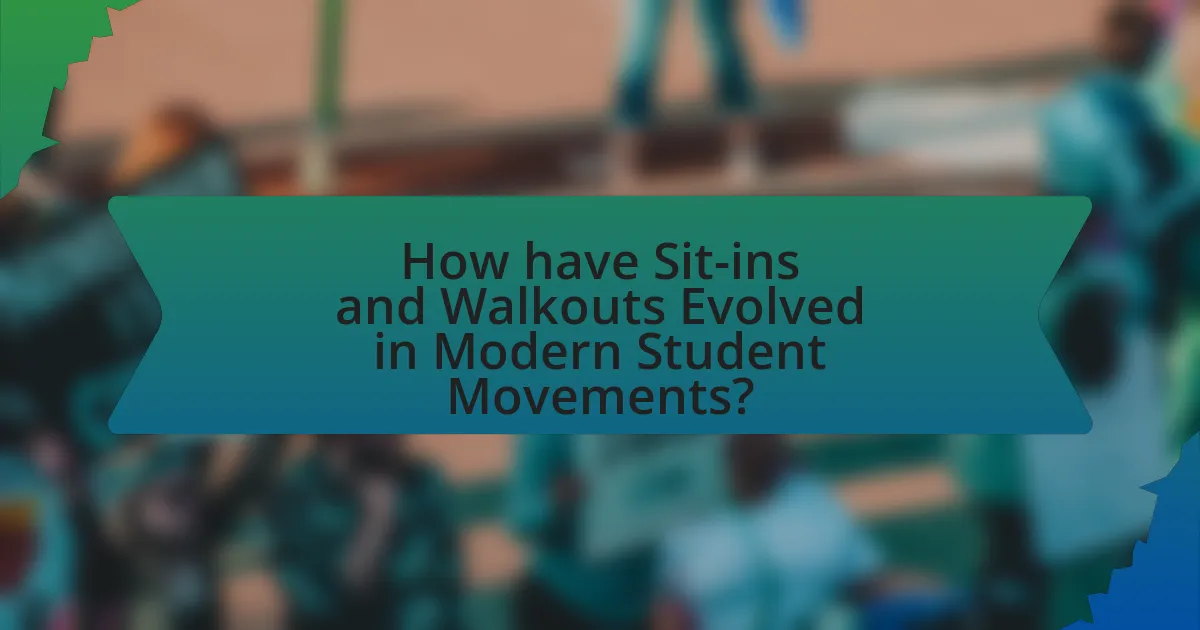
How have Sit-ins and Walkouts Evolved in Modern Student Movements?
Sit-ins and walkouts have evolved in modern student movements by integrating digital activism and broader social justice issues. Historically, sit-ins were primarily focused on racial segregation, as seen in the 1960s civil rights movement, while walkouts were often responses to specific educational policies or injustices. In contemporary contexts, these actions now frequently address a range of issues, including gun violence, climate change, and systemic inequality, often mobilized through social media platforms. For instance, the March for Our Lives movement, initiated by students after the Parkland shooting in 2018, utilized walkouts and social media to advocate for gun control, demonstrating a shift towards a more intersectional approach in student activism. This evolution reflects a growing recognition among students of the interconnectedness of various social issues and the power of collective action in the digital age.
What contemporary issues are addressed through Sit-ins and Walkouts today?
Sit-ins and walkouts today address contemporary issues such as racial injustice, climate change, gun violence, and educational reform. These forms of protest serve as powerful tools for students to express their dissent and demand systemic change. For instance, the Black Lives Matter movement has seen numerous sit-ins aimed at combating police brutality and systemic racism, reflecting ongoing societal struggles. Similarly, student walkouts for climate action, inspired by figures like Greta Thunberg, highlight the urgency of environmental issues, with students mobilizing to demand policy changes from their governments. Additionally, protests against gun violence, particularly in the wake of school shootings, have led to significant student-led walkouts advocating for stricter gun control measures. These actions demonstrate the continued relevance of sit-ins and walkouts as methods for students to engage with pressing social issues and advocate for their rights and futures.
How do modern Sit-ins and Walkouts differ from historical examples?
Modern sit-ins and walkouts differ from historical examples primarily in their use of technology and social media for organization and outreach. While historical sit-ins, such as those during the Civil Rights Movement, relied on grassroots mobilization and face-to-face communication, contemporary movements leverage platforms like Twitter and Instagram to rapidly disseminate information, coordinate actions, and amplify their messages to a global audience. For instance, the 2018 March for Our Lives, organized by students in response to gun violence, utilized social media to mobilize hundreds of thousands of participants across the United States, showcasing a scale and speed of organization that was not possible in earlier movements. This shift highlights a significant evolution in strategy, allowing modern activists to engage a wider audience and respond more swiftly to current events.
What role does social media play in organizing modern protests?
Social media serves as a crucial tool for organizing modern protests by facilitating rapid communication and mobilization among participants. Platforms like Twitter, Facebook, and Instagram enable activists to disseminate information quickly, coordinate logistics, and rally support, often leading to larger and more effective demonstrations. For instance, during the Arab Spring, social media was instrumental in organizing protests across multiple countries, allowing citizens to share real-time updates and strategies, which significantly contributed to the movements’ visibility and impact.
What lessons can current student activists learn from historical Sit-ins and Walkouts?
Current student activists can learn the importance of strategic planning and solidarity from historical sit-ins and walkouts. Historical events, such as the Greensboro sit-ins in 1960, demonstrated that well-organized, peaceful protests can effectively challenge systemic injustices, leading to significant policy changes, like the desegregation of lunch counters. Additionally, the 1968 student protests in France highlighted the power of collective action, showing that unity among diverse groups can amplify voices and demands. These examples underscore the necessity of clear objectives, community engagement, and resilience in the face of opposition, which are crucial for successful activism today.
How can the strategies used in past movements inform current activism?
Strategies used in past movements, such as sit-ins and walkouts, can inform current activism by providing effective methods for mobilization and raising awareness. Historical examples demonstrate that sit-ins, like those during the Civil Rights Movement, successfully drew public attention to racial injustices and pressured institutions to change policies. Similarly, walkouts, as seen in the 1968 student protests against the Vietnam War, showcased the power of collective action in demanding political accountability. These strategies emphasize the importance of nonviolent resistance and grassroots organization, which remain relevant in contemporary movements addressing issues like climate change and social justice. By analyzing the successes and challenges faced by past activists, current movements can adapt these strategies to enhance their impact and effectiveness.
What best practices should modern student movements adopt from historical examples?
Modern student movements should adopt the strategies of organized nonviolent protest and coalition-building from historical examples. Historical sit-ins, such as those during the Civil Rights Movement, demonstrated the effectiveness of peaceful demonstrations in drawing attention to social injustices and mobilizing public support. For instance, the Greensboro sit-ins in 1960 led to increased awareness and ultimately the desegregation of lunch counters in the South. Additionally, successful student movements often formed coalitions with other social justice groups, amplifying their voices and resources, as seen in the anti-Vietnam War protests where students collaborated with veterans and civil rights activists. These practices highlight the importance of strategic planning, unity, and nonviolent resistance in achieving meaningful change.
What are the practical steps for organizing a successful Sit-in or Walkout?
To organize a successful Sit-in or Walkout, first, establish clear objectives that articulate the purpose of the action, such as addressing specific grievances or advocating for policy changes. Next, assemble a dedicated organizing team to plan logistics, including selecting a date, location, and necessary permits, ensuring compliance with local laws. Mobilize participants through effective communication strategies, utilizing social media, flyers, and word-of-mouth to raise awareness and encourage attendance. Prepare participants by providing training on the goals, procedures, and potential consequences of the action. On the day of the event, ensure that participants are coordinated and that there are designated leaders to guide the action and address any issues that arise. Finally, document the event through photos and videos to amplify the message and maintain momentum for future advocacy efforts. Historical examples, such as the Greensboro sit-ins in 1960, demonstrate the effectiveness of these steps in mobilizing public support and achieving social change.
